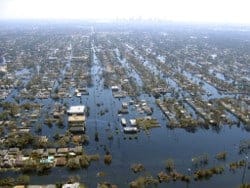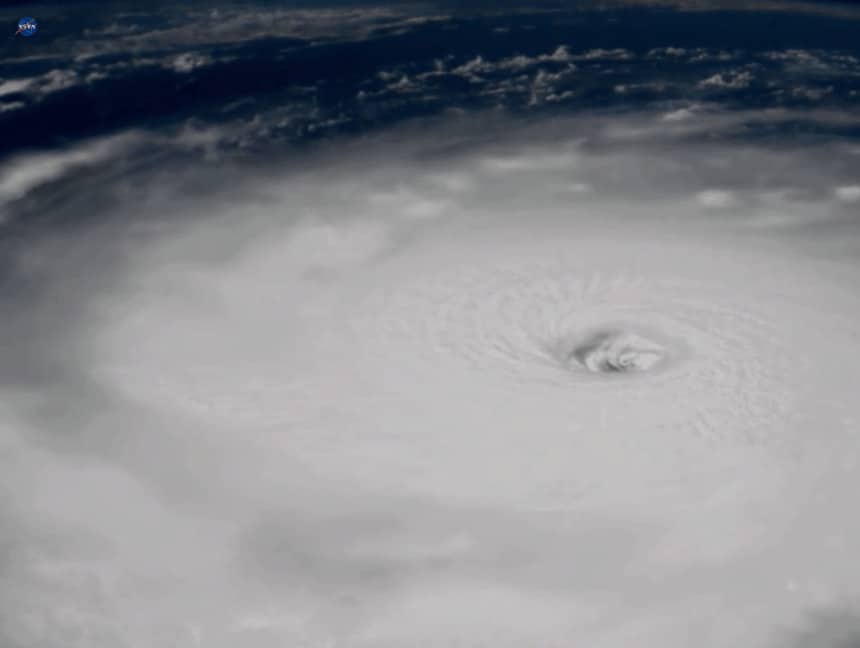In terms of lives lost, inland flooding poses more danger than a storm surge or hurricane force winds. According to Ed Rappaport of the National Hurricane Center, “In the last 30 years, inland flooding has been responsible for more than half the deaths associated with tropical cyclones in the United States.” In 1999, Hurricane Floyd was responsible for 56 deaths―50 of them due to inland flooding.
Inland flooding is not restricted to low coastal regions. The physical size of the storm may reach inland hundreds of miles and produce torrential rains. Tropical storm Alberto poured out 21 inches of rain in Georgia. Claudette was even less kind and inundated some regions in Texas with more than 45 inches―nearly four feet of rainfall!
Be Prepared for Flooding
Know what to do when a hurricane threatens. If you are in a direct path near the coast, leave for higher ground inland that is out of the storm’s predicted line of travel. If you live inland, find out if you are in a flood zone. Even a 100-year or 1000-year flood zone increases the potential for a severe flood during and after the storm. Pay attention to local news when hurricanes threaten and be prepared in advance to leave if authorities call for evacuation. Very often, the people who die in hurricanes are those that decided not to leave.
When evacuating, be aware of water on the road. Just six inches of fast-moving water is enough to make moving across the water difficult. Two feet of water will sweep most vehicles off the road and into even deeper water. Do not cross moving water or water that is higher than the bottom of your car.
Sitting out the Flood
If sudden floods leave you stranded, don’t panic. Keep a close eye on rising water levels and be prepared to move upward. Remember that flood waters carry disease and parasites and that water supplies will be contaminated. Fill containers with water and store at least one gallon per day for each person. Cook food in advance and keep it cold until you can use it. Cooking food adds days to its life.
Use a portable or standby generator to keep the power on unless water intrudes on your living space and makes using electricity dangerous. Remember that portable generators require a steady diet of fuel that you must add on a regular basis. Standby generators run on natural gas or propane which makes constant refueling or searching for fuel unnecessary.
In some areas, the waters associated with inland flooding from a hurricane can take a long time to recede, especially when levees and dikes are breached or large rivers overrun their banks. After Hurricane Katrina in 2005, New Orleans remained flooded for weeks. Being prepared to put a plan in action and having supplies on hand is always a good idea in any area prone to flooding.
Generator Use
Many people use portable generators to supply power after a hurricane knocks out electric utilities, and standby generators are quickly becoming the next must-have appliance.
Follow portable generator safety guidelines. Never run a generator indoors or where fumes can enter a home. The exhaust fumes from any internal combustion engine―including those that run on natural gas or propane―contain carbon monoxide, a deadly, odorless gas that can kill quickly in the high concentrations that form when engines are run indoors. Some deaths associated with Hurricane Sandy were caused by poor generator placement or by running them indoors.
Portable generators can provide emergency power, but supplying them with fuel is a problem. A better choice is a standby system which relies on municipal natural gas or an LP gas tank for its fuel supply. Power your essentials and conserve your supply of fuel. Sump pumps keep water out of your home, refrigerators keep your food from spoiling, and furnaces keep pipes from freezing. Air conditioners use a lot of power, but can make living through a crisis more bearable. Have a generator installed now so you’re prepared when storms threaten.

















